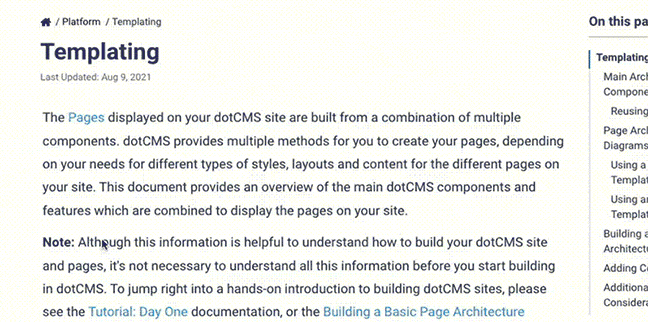These steps will help as a guide to restore dotCMS dataset (database and assets) using docker compose, on local machine for testing purposes.
Please note also that versions 22.02 and later include a simple menu button for exporting assets and database dumps.
1. Install Docker
To install Docker, follow the steps here: https://docs.docker.com/engine/install/
In most cases, the easiest approach is to install Docker Desktop, though Linux servers may instead opt for one of the packages in the Server section.
a. Install Docker Compose
If you installed Docker Desktop in Step 1, this is already installed. Otherwise, follow the steps here: https://docs.docker.com/compose/install/
2. Create docker-compose File
Copy this docker-compose.yml file to use as an example; change as needed.
version: '3.5'
networks:
db_net:
es_net:
volumes:
cms-shared:
dbdata:
esdata:
services:
################################################################################
elasticsearch:
image: docker.elastic.co/elasticsearch/elasticsearch:7.10.2
environment:
- cluster.name=elastic-cluster
- discovery.type=single-node
- data
- bootstrap.memory_lock=true
- "ES_JAVA_OPTS=-Xmx3G "
ports:
- 9200:9200
- 9600:9600
volumes:
- esdata:/usr/share/elasticsearch/data
networks:
- es_net
################################################################################
dotcms:
image: dotcms/dotcms:22.03_lts
environment:
"CATALINA_OPTS": '-Xmx1g '
"DB_BASE_URL": "jdbc:postgresql://db/dotcms"
"DB_USERNAME": 'dotcmsdbuser'
"DB_PASSWORD": 'password'
"DOT_ES_AUTH_BASIC_PASSWORD": 'admin'
"DOT_ES_ENDPOINTS": 'http://elasticsearch:9200'
"DOT_INITIAL_ADMIN_PASSWORD": 'admin'
depends_on:
- db
- elasticsearch
volumes:
- cms-shared:/data/shared
networks:
- db_net
- es_net
ports:
- "8082:8082"
- "8443:8443"
################################################################################
db:
image: dotcms/postgres:15
command: postgres -c 'max_connections=400' -c 'shared_buffers=512MB' -c 'effective_cache_size=1536MB' -c 'maintenance_work_mem=128MB'
environment:
"POSTGRES_USER": 'dotcmsdbuser'
"POSTGRES_PASSWORD": 'db_pass'
"POSTGRES_DB": 'dotcms'
networks:
- db_net
volumes:
- dbdata:/var/lib/postgresql/data
restart: "unless-stopped"
ports:
- "5432:5432"
3. Create Directories
a. Base Directories
Create the directory paths shared and logs on the same path that the docker-compose.yml file will read from:
mkdir shared logs
b. Asset Directories
Next, create an assets directory under the shared path like this: ./shared/assets/ and place the assets from your dataset on that folder.
4. Move Plugins
If there are any Dynamic Plugins (OSGi), place them in the ./shared/felix/load/ directory.
Any undeployed OSGi plugins should be moved to ./shared/felix/undeployed/
5. Adjust Folder Permissions
Change the permissions on the shared and logs paths to userid and groupid 65001, which is the userid that dotCMS runs inside the container:
sudo chown -R 65001.65001 shared
sudo chown -R 65001.65001 logs
This should result in something like the following:
dotcms-standalone $ ls -lha
total 20K
drwxrwxr-x 4 dotcmsuser dotcmsuser 4.0K Jan 8 14:31 .
drwxrwxr-x 4 dotcmsuser dotcmsuser 4.0K Jan 7 08:46 ..
-rw-rw-r-- 1 dotcmsuser dotcmsuser 1.7K Jan 7 14:43 docker-compose.yml
drwxrwxr-x 2 65001 65001 4.0K Jan 8 14:31 logs
drwxrwxr-x 2 65001 65001 4.0K Jan 8 14:31 shared
6. Start the DB Container
For now, just start the DB container to restore the database (use -d to run it as daemon):
docker compose up db
7. Restore Database
Restore the database by connecting with the credentials on the docker-compose.yml file, similar to restoring any other database dump in Postgresql:
psql -U dotcmsdbuser dotcms -h localhost
Enter your password when prompted, and then use:
dotcms=# \i dotcms-prod-restore.sql
8. Stop the Database Container
Stop the docker compose with stop or control + c, if it was not running as daemon.
docker compose stop
9. Reinitialize and Reindex
Start docker compose with all the services (use -d to run it as daemon):
docker compose up -d
At this point, you should be able to access your dotCMS instance running with the restored dataset by accessing http://localhost:8082 in the browser. To conclude the restoration process, simply complete a full reindex of content.
Please note that this has been an example presented for testing purposes, and as such is simpler than a typical production environment.


